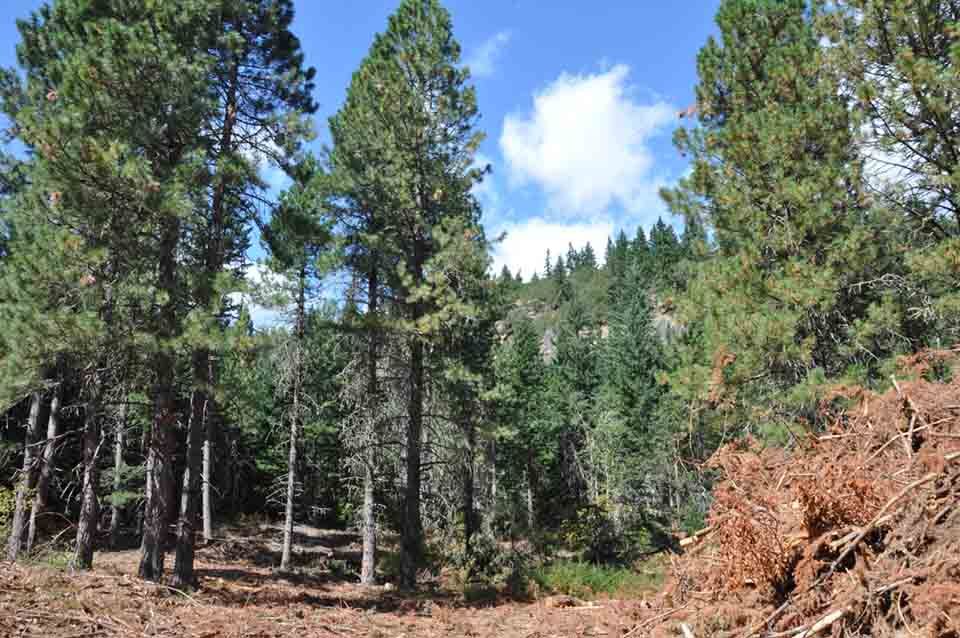Hundreds of Trees are Dying in a Douglas “Fir-Mageddon”

ASHLAND, Ore. — While a helicopter lifts hundreds of dead trees from the Siskiyou Mountains in southwestern Oregon, Ashland Fire and Rescue coordinates a project to thin 5,000 acres of dead and dying Douglas firs before the wildfire season begins.
Read: Helicopter Logging Will Rid Ashland Forest Of Dying And Dead Douglas Fir Trees
There are between 20% to 80% dead trees in pockets of the forest, in a decline spiral now referred to as a “fir-mageddon,” according to Ashland Fire and Rescue wildlife division chief, Chris Chambers.
Ashland Fire and Rescue Helps Coordinate Mountainside Project
Ashland Fire and Rescue are hoping to reach a goal of removing 20 loads of dead Douglas fir trees every hour by helicopter, three to four stripped logs at a time. The labor-intensive project aims to clear dead timber that will fuel wildfire flames if left unchecked.
Chambers is concerned about the widespread damage that could be caused to the communities situated at the foothills of the Siskiyou Mountain Park. The Ashland division chief is also concerned that wildfire could forever change the composition of the forest, as increasingly hot weather caused by climate change stunts tree growth after fire damage. Chambers says the thinning project will “soften the blow.”
‘Trees on the Edge’
While the Ashland project concentrates on eradicating dead timber from the mountainside forest, the reason for the death rate of Douglas firs remains the subject of debate.
The co-author of ‘Trees on the Edge,’ a paper written last year by retired extension forester at Oregon State University, Max Bennett, suggests that Douglas firs planted on the perimeters of forests are more susceptible to die. Bennett says the forest in Jacksonville, for example, is an environment where Douglas fir trees grow on the edge. He says when weather conditions change, such as hot summers and periods of drought, the Douglas firs are ‘pushed over the edge.’
The co-author believes that hotter weather and lower rainfall is affecting the ability to draw water up from the roots and is stressing out the Douglas fir tree population. He says these conditions are causing the trees to have ‘heart attacks.’
Midway up Woodrat Mountain in Applegate Valley, entomologist Laura Lowrey is using an ax to cut a square of bark from a distressed Douglas fir. She pulls off the piece of bark, uncovering track marks of the flathead fir borer, a metallic green bug that she refers to as ‘the cleanup crew.’ The entomologist at the U.S. Forest service and the Bureau of Land Management, Lowrey says the insects invade dying trees, recycling them back into the soil.
Unfortunately, says Lowrey, the flathead fir borer beetle population is exploding because of the number of dying and dead trees in southwestern Oregon. Aerial surveys reveal that the beetles were present in dead Douglas firs at a rate of 50,000 acres in 2019 to 375,000 acres by 2022.
Tree Thinning is Motivated by Timber Sales, Say Residents
Many Rogue Valley residents believe that the thinning project by the city of Ashland and the Bureau of Land Management (BLM) is not about public safety or forest health, but rather is motivated by the sales of timber. The BLM is thinning 5,000 acres of the 876,000 acres under Medford District control to protect residents and roads. The BLM will call for public comment this summer on its proposed environmental assessment for the project.
Applegate Siskiyou Alliance executive director, Luke Ruediger, says the removal of dead Douglas firs is starting to resemble ‘broadscale clearcutting’ rather than hazard clearance. Ruediger believes that beetle-infested dead trees should be left as animal habitat standing snags. He is concerned that an aggressive forest management approach will make the Douglas firs vulnerable to increased drought and beetle infestation mortality.
Ruediger says it would be far better to assist residents who live near forests to create defensible spaces and to harden their homes from wildfire risks.
Tracking Climate Change by Transferring Douglas Fir Seeds from One Area to Another
Bryan Reatini, a geneticist with Forest Service, believes that by transferring seeds that have adapted to different climate conditions, researchers would be able to track climate change. Reatini was speaking from the J. Herbert Stone Nursery in Central Point where Douglas firs have been cultivated from different seed sources as part of a climate change study project.
The geneticist points out that the Washington coast climate is vastly different to that of Southern Oregon, and that firs that have adapted to the Washington coast are unsuitable to Southern Oregon. The main goal, says Reatini, is to assist land managers with future planning when reforesting areas such as the Applegate Valley and the hills around Ashland. The researchers are attempting to mimic the natural changes in tree growth during climate change.
Reatini is optimistic that with lots of thought, innovation, and effort, healthy forest populations can be maintained.
